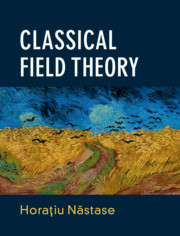Book contents
- Frontmatter
- Dedication
- Contents
- Preface
- Acknowledgements
- Introduction
- Part I General Properties of Fields; Scalars and Gauge Fields
- 1 Short Review of Classical Mechanics
- 2 Symmetries, Groups, and Lie algebras; Representations
- 3 Examples: The Rotation Group and SU(2)
- 4 Review of Special Relativity: Lorentz Tensors
- 5 Lagrangeans and the Notion of Field; Electromagnetism as a Field Theory
- 6 Scalar Field Theory, Origins, and Applications
- 7 Nonrelativistic Examples:WaterWaves and Surface Growth
- 8 Classical Integrability: Continuum Limit of Discrete, Lattice, and Spin Systems
- 9 Poisson Brackets for Field Theory and Equations of Motion: Applications
- 10 Classical Perturbation Theory and Formal Solutions to the Equations of Motion
- 11 Representations of the Lorentz Group
- 12 Statistics, Symmetry, and the Spin-Statistics Theorem
- 13 Electromagnetism and the Maxwell Equation; Abelian Vector Fields; Proca Field
- 14 The Energy-Momentum Tensor
- 15 Motion of Charged Particles and ElectromagneticWaves; Maxwell Duality
- 16 The Hopfion Solution and the Hopf Map
- 17 Complex Scalar Field and Electric Current: Gauging a Global Symmetry
- 18 The Noether Theoremand Applications
- 19 Nonrelativistic and Relativistic Fluid Dynamics: Fluid Vortices and Knots
- Part II Solitons and Topology; Non-Abelian Theory
- Part III Other Spins or Statistics; General Relativity
- References
- Index
15 - Motion of Charged Particles and ElectromagneticWaves; Maxwell Duality
from Part I - General Properties of Fields; Scalars and Gauge Fields
Published online by Cambridge University Press: 04 March 2019
- Frontmatter
- Dedication
- Contents
- Preface
- Acknowledgements
- Introduction
- Part I General Properties of Fields; Scalars and Gauge Fields
- 1 Short Review of Classical Mechanics
- 2 Symmetries, Groups, and Lie algebras; Representations
- 3 Examples: The Rotation Group and SU(2)
- 4 Review of Special Relativity: Lorentz Tensors
- 5 Lagrangeans and the Notion of Field; Electromagnetism as a Field Theory
- 6 Scalar Field Theory, Origins, and Applications
- 7 Nonrelativistic Examples:WaterWaves and Surface Growth
- 8 Classical Integrability: Continuum Limit of Discrete, Lattice, and Spin Systems
- 9 Poisson Brackets for Field Theory and Equations of Motion: Applications
- 10 Classical Perturbation Theory and Formal Solutions to the Equations of Motion
- 11 Representations of the Lorentz Group
- 12 Statistics, Symmetry, and the Spin-Statistics Theorem
- 13 Electromagnetism and the Maxwell Equation; Abelian Vector Fields; Proca Field
- 14 The Energy-Momentum Tensor
- 15 Motion of Charged Particles and ElectromagneticWaves; Maxwell Duality
- 16 The Hopfion Solution and the Hopf Map
- 17 Complex Scalar Field and Electric Current: Gauging a Global Symmetry
- 18 The Noether Theoremand Applications
- 19 Nonrelativistic and Relativistic Fluid Dynamics: Fluid Vortices and Knots
- Part II Solitons and Topology; Non-Abelian Theory
- Part III Other Spins or Statistics; General Relativity
- References
- Index
Summary
In this chapter, we study the motion of charges and electromagnetic waves. After studying static charges, uniformly moving charges, and the standard electrostatic method of the mirror image charges, we consider the multipole expansion of the electric and magnetic fields. The electric field is generated by monopole (electric charge) and higher multipole, and magnetic field by dipole and higher multipoles. Electromagnetic waves are then studied. For arbitrary moving charges, we calculate the retarded potentials, and in particular the Lienard–Wiechert forms. We then show that we need at least dipoles to generate electromagnetic waves. We end by describing Maxwell duality.
Keywords
Information
- Type
- Chapter
- Information
- Classical Field Theory , pp. 137 - 149Publisher: Cambridge University PressPrint publication year: 2019
